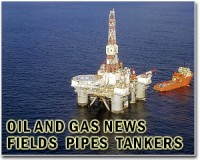 |
Durham, England (UPI) Oct 14, 2010 Britain could reap a $240 billion North Sea oil bonanza using carbon dioxide to extract oil, but only if the current infrastructure is enhanced, a study says. Research at Durham University shows that using CO2 to enhance recovery could yield an extra 3 billion barrels of oil during the next 20 years, a university release said. That amount of oil could power, heat and fuel transport in Britain for two years with every other form of energy switched off, researchers say. The process is almost carbon neutral, with almost as much carbon being put back in the ground as would be taken out, they say. "Time is running out to make best use of our precious remaining oil reserves because we're losing vital infrastructure as the oil fields decline and are abandoned," Jon Gluyas, a professor in Durham's department of earth sciences, say. "Once the infrastructure is removed, we will never go back and the opportunity will be wasted. "We need to act now to develop the capture and transportation infrastructure to take the CO2 to where it is needed," Gluyas said. Oil is usually recovered by flushing oil wells through with water pressure. Since the 1970s oil fields in Texas have been successfully exploited by pumping CO2 as a liquid into parts of the reservoirs water injection doesn't reach, resulting in a 4 percent to 12 percent increase in oil production.
Share This Article With Planet Earth
Related Links Powering The World in the 21st Century at Energy-Daily.com
 European bid to freeze deepwater drilling collapses
European bid to freeze deepwater drilling collapsesBrussels (AFP) Oct 13, 2010 A bid to freeze deepwater drilling in Europe in the wake of the Gulf of Mexico disaster collapsed Wednesday under pressure from the multi-billion North Sea oil industry. European Union Energy Commissioner Guenther Oettinger announced moves to tighten the issuing of drilling permits to ensure there is no repeat of the devastating Gulf of Mexico disaster in the United States. But a tempora ... read more |
|
| The content herein, unless otherwise known to be public domain, are Copyright 1995-2010 - SpaceDaily. AFP and UPI Wire Stories are copyright Agence France-Presse and United Press International. ESA Portal Reports are copyright European Space Agency. All NASA sourced material is public domain. Additional copyrights may apply in whole or part to other bona fide parties. Advertising does not imply endorsement,agreement or approval of any opinions, statements or information provided by SpaceDaily on any Web page published or hosted by SpaceDaily. Privacy Statement |